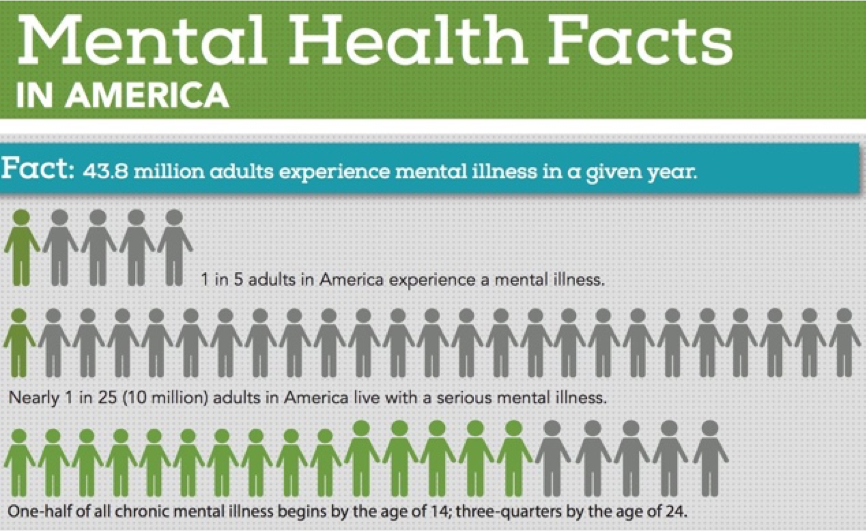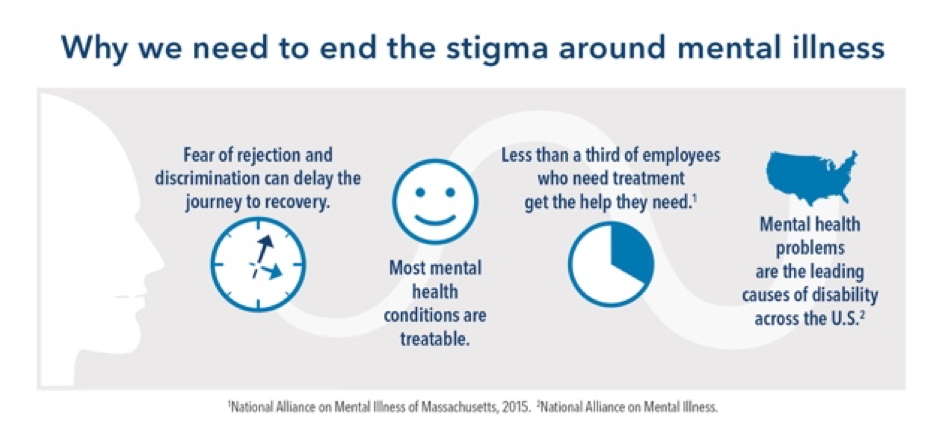
Breaking the Mental Health Stigma at Work
While many businesses and organizations have focused on creating more accepting environments in the last 10 years, mental illness remains taboo in the American workplace.
Employees and employers alike often hesitate to discuss mental health in the office due to negative stigmas, despite the work of associations like the National Alliance on Mental Illness and the World Federation of Mental Health.
People with mental illness are often the victim of stereotypes, being portrayed as irresponsible, indecisive, less competent or even dangerous. They are more likely to face rejection, bullying or discrimination for their illness since it’s often misrepresented as simply a character weakness.
In this article, we’ll be detailing the steps to fostering a more open, understanding culture in your office environment, starting with the importance of understanding the facts of mental illness.
Prevalence of Mental Illness
Did you know that depression was found to be the leading cause of disability worldwide?
 Credit: National Alliance on Mental Illness
Credit: National Alliance on Mental Illness
Depression is defined by the American Psychiatric Association as a common and serious medical illness that negatively affects how people feel, think and act. The Center for Workplace Health estimates that as much as 7% of full-time workers experience major depression. MDD can easily cut down workplace productivity along with a person’s overall quality of life with symptoms like:
- Feeling profoundly sad or irritable for the majority of the day
- Drastic changes in appetite and weight
- Extreme loss of energy
- Increased feelings of worthlessness
Depression isn’t the only mental illness that rears its head in American workplaces. According to the Anxiety and Depression Association of America, approximately 40 million adults are affected by anxiety every year. According to the American Psychological Association, anxiety is a disorder characterized by feelings of tension, worried thoughts and physical changes like increased blood pressure. There are several types of anxiety disorders, including:
- Generalized Anxiety Disorder (GAD)
- Panic Disorder (PD)
- Social Anxiety Disorder
- Obsessive-Compulsive Disorder (OCD)
Many times, if someone is suffering from either anxiety or depression, they might soon develop the other. In fact, nearly one-half of those diagnosed with depression are also diagnosed with an anxiety disorder. And that isn’t the only risk: people with unaddressed mental health conditions tend to be more likely to experience other serious medical conditions, such as heart disease, diabetes and stroke.
As depression and anxiety levels continue to rise, and with suicide remaining one of the leading causes of death for people age 15-34 in the US, it’s more important than ever to create an environment in your workplace that encourages people to seek treatment for their mental illness.
Mental Health Stigmas in the Workplace
For many American workplaces, there aren’t any existing channels to discuss mental illness. Since the average employee only takes 54% of their vacation time, it’s not exactly surprising that your team may not feel comfortable requesting a mental health day.
In fact, they may not feel comfortable asking for any additional support, and the results are staggering:
- Fewer than 1 in 3 employees who struggle with a mental health condition get the help they need.
- 8 of 10 workers with a mental health condition report that shame and stigma prevent them from seeking treatment.
- 62% of missed workdays can be attributed to mental health conditions.
- Depressed employees are 20% to 40% more likely to become unemployed because of their condition.

Unfortunately, when ignored, mental health issues hold back your whole business, not just those employees who are directly affected.
The consequences of these illnesses going unaddressed cost your business in the form of absenteeism and presenteeism. Presenteeism (drastically reduced productivity) due to depression is rising much more sharply than absenteeism. This suggests employees are continuing to come to work despite struggling with debilitating symptoms that interfere with their responsibilities.
Overall, untreated mental health conditions cost the economy $200 billion every year.
Luckily, it’s been proven that workplaces that invest in being mental health-conscious save on healthcare costs and become more positive places to work. As your employees take advantage of the resources and help you provide them, they’ll start feeling better about their jobs, too. More than 80% of employees who receive treatment for their mental illness report improved job satisfaction.
How to Better Your Office
Creating a more accepting work environment starts with opening a dialogue about mental illness with your entire team.
According to the NAMI’s StigmaFree Company initiative, it’s important to stress to employees that mental health conditions are not the result of personal weakness, lack of character or poor upbringing, and focus on facts.
If you’re in a position of leadership, it’s your responsibility to foster an environment where vulnerability and honesty are valued and discussing mental health can happen freely and without consequence for employees.
Sparking these positive changes starts by:
- Recognizing mental illness as a legitimate workplace concern.
- Developing policies that address mental health. For example, employers can add in a protocol for taking mental health days to the employee handbook.
- Providing management training. Some managers may not have the skills or experience to support employees with a history of mental illness. With training, your leadership team can gain the confidence to address these sensitive issues.
- Adapting your language. Mental illness is often discussed in a way that dismisses how serious it is — describing it as “a phase” someone is going through, for example. The Hogg Foundation for Mental Health developed a guide to choosing more respectful words when discussing mental health.
- Investing in a workplace wellness program. Gallup research shows managers influence 70% of their team’s engagement, and that engaged workers are 28% more likely to participate in a wellness program, which may be able to help someone in recovery.
- Showing understanding. It’s okay if you can’t relate to what someone with mental illness might be feeling. It is still important to have empathy and show support for someone’s struggle, and that you see them as a person, not their condition.
When your company prioritizes mental health, you’re establishing an environment that is more likely to be comfortable, productive and engaging for your employees, and the steps for getting there are achievable for any company, regardless of size.
At IPMG, we help organizations manage the mental health of their workforce by identifying employees in need of support through custom triggers and clinical outreach, and by organizing the appropriate resources so they are able to address their needs. To learn more, contact us today.


